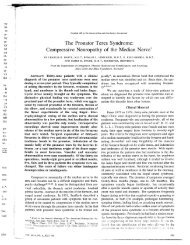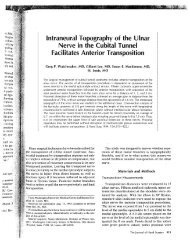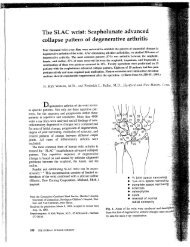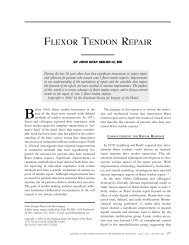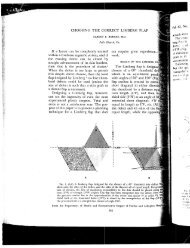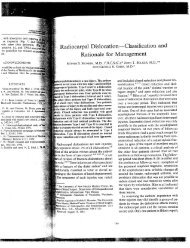Pollicization of the Index Finger
Pollicization of the Index Finger
Pollicization of the Index Finger
Create successful ePaper yourself
Turn your PDF publications into a flip-book with our unique Google optimized e-Paper software.
1606 DIETER BUCK-GRAMCKo<br />
FIG.<br />
Figs. :~ 2-A and 2-B: Disappointing result <strong>of</strong> a trial to pollicise <strong>the</strong> index finger performed else~<br />
where. An osteotomy <strong>of</strong> <strong>the</strong> metacarpal and resection <strong>of</strong> <strong>the</strong> proximal interphal~ngeal joints was<br />
done, but <strong>the</strong> essential features <strong>of</strong> shortening muscle stabilization, and adequate rotation were<br />
lacking. ,<br />
results presented in this paper show that <strong>the</strong>se statements are not correct if small but<br />
important details <strong>of</strong> technique are observed.<br />
The technique <strong>of</strong> pollicization in congenital cases is based on <strong>the</strong> procedure:<br />
evolved for <strong>the</strong> reconstruction <strong>of</strong> <strong>the</strong> thumb in traumatic amputations. From <strong>the</strong> fas<br />
cinating literature concerning this problem, I would emphasize <strong>the</strong> contributions in<br />
operative technique by Gosset, Hilgenfeldt, and Littler 10,11, who developed<br />
fundamental principles for pollicization in cases <strong>of</strong> aplasia and hypoplasia <strong>of</strong> <strong>the</strong><br />
thumb. O<strong>the</strong>r authors such as Harrison z, s and Riordan 12 also have made important<br />
contributions. ’<br />
From 1959 to <strong>the</strong> present I have performed 114 pollicization operations, and<br />
<strong>of</strong> this number 100 were in congenital cases. The experience with this large number<br />
<strong>of</strong> pollicizations has led to modifications in <strong>the</strong> operative technique with improvement<br />
<strong>of</strong> <strong>the</strong> results z,3,4. Twenty-one <strong>of</strong> <strong>the</strong> seventy-three patients had unilateral<br />
problems, with normal contralateral upper extremities. In sixteen <strong>the</strong>re were ot<br />
THE JOURNAL OF BONE AND JOINT suRGERY<br />
(Fig.<br />
vide!



